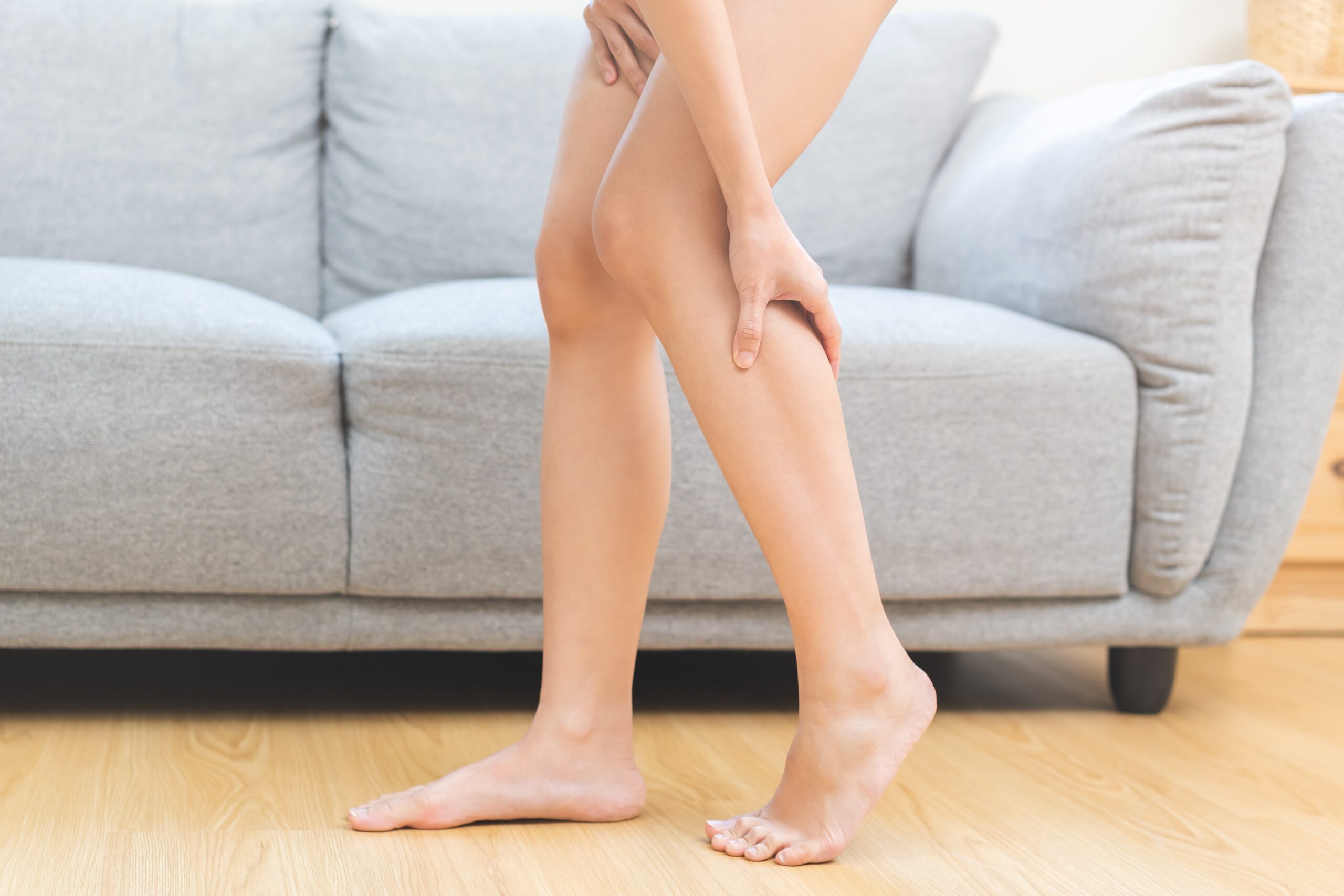Leg cramps are sudden, painful contractions of the leg muscles. They often strike at night, and people call them nocturnal leg cramps or Charley horses.
These involuntary contractions usually affect the calf muscles but can also involve the thighs or feet.
Most episodes are harmless. However, frequent cramps may point to dehydration, nutrient deficiencies, or health conditions such as circulation problems.
Below, we’ll cover common causes of leg cramps, practical relief tips, and when to reach out for care.
Top 6 Causes of Leg Muscle Cramps
Here are the most common causes of leg cramps and why they happen.
1. Dehydration and Electrolyte Imbalance
Leg cramps at night often begin when the body lacks fluids. Without enough hydration, blood flow to the muscles can drop. That restriction makes leg muscles more prone to sudden spasms.
Electrolytes such as potassium, magnesium, and sodium control how muscles contract and relax. Low levels may cause muscle cramps and sudden pain, particularly after physical activity or hot weather.
Certain medical conditions, such as kidney failure or liver disease, also increase this risk. Pregnant women may experience leg cramps because fluid shifts and extra weight affect circulation.
A diet rich in minerals can help prevent cramps. Bananas, leafy greens, and nuts support muscle health.
Some people also use magnesium citrate, though you should check with a doctor before adding supplements.
2. Muscle Overuse and Fatigue
Overworked muscles are a frequent cause of leg cramps at night. A demanding exercise routine can strain the calf muscles and trigger nocturnal cramps. Even light activity may set off spasms if the muscles are already tired.
Prolonged standing adds extra demand, which makes the muscles more vulnerable to cramping. Pregnant women also face a higher risk because extra weight increases muscle fatigue.
Calf-stretching exercises before sleep may help reduce the chance of cramps caused by muscle fatigue.
3. Poor Circulation
Poor circulation restricts oxygen flow to the leg muscles. Without proper oxygen, the muscles may cramp during rest and cause sudden pain.
Peripheral vascular disease and venous insufficiency both narrow blood vessels and raise the risk of chronic, persistent leg cramps.
High blood pressure and high cholesterol also strain circulation by damaging blood vessels.
If circulation-related cramps occur often, medical conditions such as diabetic nerve damage or cardiac arrhythmias may be involved.
In those cases, medical care is necessary to identify the underlying cause and recommend treatment.
4. Medication Side Effects
Certain medications can trigger leg cramps by altering the way muscles contract. Diuretics for high blood pressure, cholesterol drugs, and osteoporosis treatments are common examples.
These prescriptions can change fluid balance or affect nerves, which increases the chance of cramps.
Quinine treatment was once prescribed to prevent leg cramps. The National Library of Medicine later linked it to serious adverse effects such as cardiac arrhythmias, so doctors rarely recommend it now.
5. Alcohol and Nerve Damage
Heavy alcohol use can damage nerves and raise the risk of night leg cramps. This condition, known as alcoholic neuropathy, develops when alcohol lowers levels of vitamins such as B1, B6, B12, and folate.
Without these nutrients, nerves can’t communicate properly with the muscles.
Alcohol-related nerve damage may cause more than cramps. Numbness, weakness, or swelling in the legs often appear with other symptoms. Severe pain is possible in advanced cases.
Reducing alcohol intake and restoring lost vitamins can ease some problems. If leg cramps continue, they may point to an underlying condition that requires medical care.
6. Pregnancy-Related Leg Cramps
Pregnancy often increases the risk of nocturnal leg cramps, especially in the third trimester. Extra weight places more demand on the leg muscles, and circulation changes add further strain.
Cramps may strike the thighs and last only a few seconds. They usually occur at night when blood flow slows during sleep.
While muscle spasms are common, severe pain or frequent episodes may point to a more serious health condition.
If cramps persist, a provider may recommend gentle stretching routines, massage, hydration, or additional tests to rule out medical conditions.
How to Relieve and Prevent Leg Cramps
Night leg cramps often strike without warning, but specific methods can relieve the pain and reduce recurrence:
- Stretch and massage: At the first sign of a cramp, extend your leg and flex your foot upward. Hold for a few seconds. Massage the muscle firmly afterward to release tension.
- Apply heat or cold: Use a heating pad to relax tight muscles. Apply an ice pack later if soreness or inflammation develops.
- Stay hydrated: Drink water throughout the day. Low fluid levels limit normal muscle function and increase the chance of nocturnal cramps.
- Strengthen nutrition: Add bananas, almonds, spinach, and yogurt to your meals. These foods supply potassium, magnesium, and calcium, which regulate nerve signals and muscle contractions.
- Pre-bed routine: Do calf-stretching exercises before sleep. Stand on a step with your heels lowered for 30 seconds. A short session on a stationary bicycle before bed may also help.
- Alternate posture: If your job requires long hours sitting or standing, change position every 30 minutes. Frequent movement keeps blood flowing through the leg muscles.
- Adjust sleep setup: Keep blankets loose around your feet. Tight bedding can push your toes downward and trigger cramps.
- Seek medical guidance: Idiopathic leg cramps, or cramps tied to restless legs syndrome, may require treatment with muscle relaxants.
These methods provide both immediate relief and long-term prevention.
When to See a Doctor About Leg Cramps
Occasional cramps usually pass without concern, but frequent or intense episodes can point to something more serious.
Reach out to a provider if cramps disrupt sleep several nights a week or if the pain lasts longer than expected.
New prescriptions can also trigger cramps. If they begin soon after you start medication, your provider can review whether the drug is responsible.
Persistent episodes signal more than routine discomfort. In these cases, medical evaluation can rule out dangerous risk factors and guide treatment.
Relieve Muscle Strain and Leg Cramps With Wellness and Pain
Frequent leg cramps can break sleep, drain energy, and limit your activity the following day. If home remedies such as stretching, hydration, or diet changes haven’t made a difference, it may be time to consider professional care.
At Wellness and Pain, we focus on treatments that address the source of your cramps as well as the discomfort they cause.
Massage therapy helps release tight muscles and support circulation. Acupuncture balances nerve activity that can trigger contractions. IV hydration restores fluids and electrolytes, which are critical for proper muscle function.
Our team builds care plans around your health history and daily challenges. Whether cramps stem from muscle fatigue, circulation issues, or a medical condition, we match treatment to the cause.
Don’t let nocturnal leg cramps continue to disrupt your nights. Book an appointment with Wellness and Pain to restore comfort and improve muscle health.
FAQs About Leg Cramps
What is the main cause of cramps in the legs?
The most common causes of leg cramps are dehydration, muscle fatigue, and circulation problems. They may also be linked to conditions such as diabetes or kidney failure.
What deficiency causes leg cramps?
Low potassium, magnesium, or calcium levels can trigger cramps. These minerals regulate normal muscle contractions and relaxation.
How do I stop the cramping in my legs?
You can stop leg cramps by stretching the affected muscle, flexing your foot upward, and massaging the area. Applying heat can relax tight muscles, while ice can ease soreness afterward.
What drink stops leg cramps?
Water is the best option to relieve leg cramps because dehydration is a common trigger. Drinks with electrolytes, such as coconut water, can also help support muscle function.











